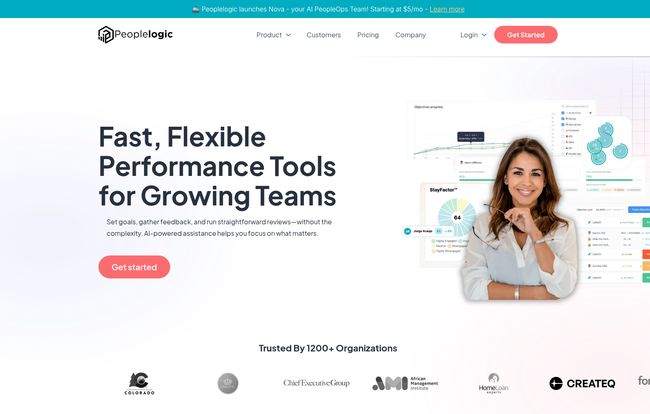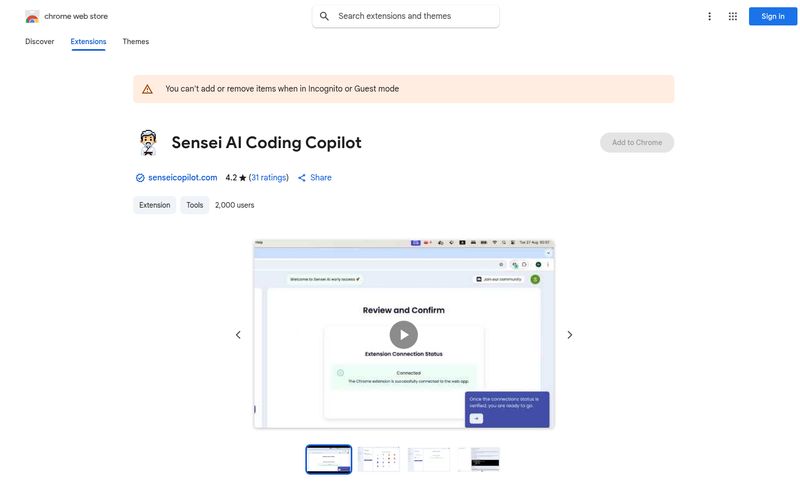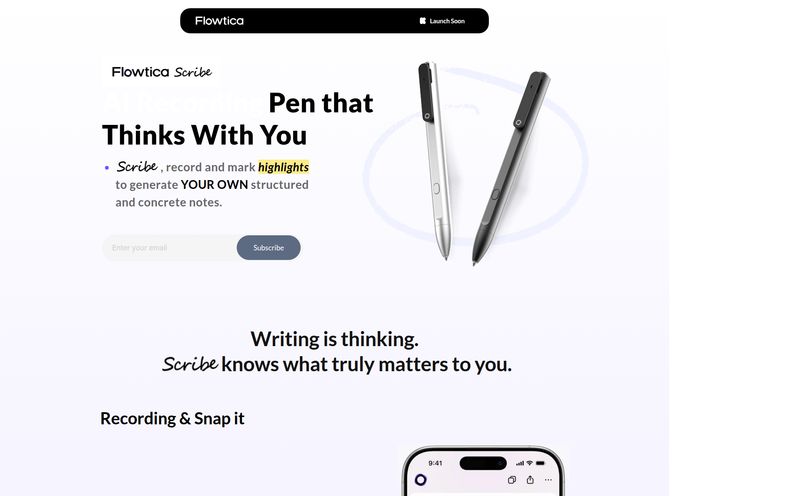I still get a cold shiver thinking about my first-ever corporate performance review. It was a sterile, once-a-year affair in a windowless room, where a manager I barely spoke to read from a checklist of my supposed failings and successes from the past 11 months. It was awkward, mostly useless, and felt completely disconnected from the actual work I was doing. Sound familiar? Yeah, I thought so. For years, we've been stuck in this cycle, using spreadsheets and outdated processes to manage the most important part of any business: its people.
So when a platform like Peoplelogic pops up on my radar, flashing terms like “AI-Powered Insights” and “Modern Teams,” my inner SEO and tech geek gets curious. But my cynical side, the one who’s seen a dozen “revolutionary” HR platforms come and go, raises an eyebrow. Is this another tool that promises the world but delivers a glorified to-do list? Or is it something… different? I decided to take a closer look.
So, What Exactly is Peoplelogic?
At its core, Peoplelogic bills itself as an AI-enabled performance, productivity, and people intelligence platform. That's a mouthful, I know. Let’s translate that from marketing-speak. Think of it as a central hub for all the squishy, hard-to-measure stuff that actually determines if a team is successful. We're talking about goal setting (OKRs), regular check-ins (1-on-1s), performance reviews that don't suck, and building individual growth plans.
But the secret sauce, the thing that makes it stand out from a simple project management tool, is the AI layer. It connects to the tools your team is already using—think Slack, Jira, Google Workspace, etc.—and analyzes activity patterns to give you real insights. It’s designed to help managers become better leaders by spotting trends, like a team member heading for burnout or a project that's losing momentum, before they become full-blown disasters. It's less about spying and more about creating a data-informed support system. A pretty interesting proposition, right?

Visit Peoplelogic
The Features That Actually Matter
A platform is only as good as its features, and Peoplelogic has a pretty robust list. But instead of just listing them, let’s talk about the ones that I think genuinely move the needle for a growing business.
The AI Co-pilot is More Than a Gimmick
Let's be real, “AI” is the biggest buzzword since “synergy.” But Peoplelogic’s AI, which they call Nova, seems to have some real chops. It’s not just generating fluffy text. It’s acting like a junior analyst for your People Ops team. By looking at anonymized data from your integrated apps, it can generate recommendations. For instance, it might suggest, “Team Alpha has had a high number of PRs merged this week, consider giving public praise,” or “Alex seems to be working late consistently, maybe schedule a 1-on-1 to check in.” This turns abstract data into actionable management advice. That’s a powerful shift from reactive to proactive leadership.
Taming the OKR Beast
Objectives and Key Results (OKRs) are fantastic in theory, but in practice? They often end up in a forgotten spreadsheet, completely detached from daily work. I've seen it happen a hundred times. Peoplelogic aims to fix this by integrating goal-setting directly into the workflow. You can set company-wide objectives and have teams and individuals align their own goals to them. The platform provides dashboards to track progress in real-time, making it clear how everyone's work contributes to the bigger picture. It makes accountability visual and a whole lot easier to manage.
Making 1-on-1s and Reviews Less Awkward
This brings me back to my original horror story. Peoplelogic encourages a culture of continuous feedback, which is the antidote to the dreaded annual review. It provides structured templates for 1-on-1s, making those conversations more productive and less “So, uh, how's it going?” You can track action items, reference past conversations, and tie everything back to an employee’s Individual Development Plan (IDP). It transforms reviews from a backward-looking critique into a forward-looking coaching session. And the ability to give anonymous feedback or public praise on the fly? That’s just smart team building.
Let's Talk Money: The Peoplelogic Pricing Structure
Alright, this is the part everyone secretly scrolls down to first. How much does it cost? Peoplelogic is surprisingly transparent with its main offering, which I appreciate. Here’s the breakdown:
| Plan | Price | Key Features Included |
|---|---|---|
| Peoplelogic Platform | $3,588 /year | Goals & Objectives (OKRs), Performance Reviews, 1:1 Meetings, IDPs, Surveys, Public Praise, Anonymous Feedback, AI Co-pilot, and White-glove Customer Success. |
Now, $3,588 a year isn't pocket change, but when you consider what you're getting, it’s actually quite competitive. For a team of, say, 30 people, that breaks down to less than $10 per employee per month. If the AI can help you retain just one key employee who was on the verge of burning out, the platform has paid for itself several times over. My only gripe? They mention a “Startup Plan” and “Enterprise Features” like SSO, but you have to “Talk to Sales” to get any details. C'mon guys, it’s 2024. Just give us a ballpark! This kind of sales-gating is a pet peeve of mine, but it's a common one in the B2B SaaS world.
Where Peoplelogic Shines (and Where It Stumbles)
No tool is perfect, so let’s get into the nitty-gritty. In my book, the biggest win for Peoplelogic is its holistic approach. It’s not just a single-point solution; it’s an ecosystem. The AI-driven recommendations are the true differentiator, elevating it from a simple tracking tool to a strategic partner. The emphasis on continuous, forward-looking development over punitive, backward-looking reviews is exactly where modern workplaces need to go. And the integration with tools like Slack means it fits into how people actually work, reducing the friction of adopting something new.
On the flip side, the forced sales call for startup and enterprise pricing is a bit of a drag. It puts a barrier up for smaller companies or large organizations that just want to do their initial research without getting into a sales funnel. I also feel like the success of the platform is heavily dependent on good data hygiene. If your teams aren't using their integrated tools (like Jira or GitHub) consistently, the AI insights will be weak. It’s a classic “garbage in, garbage out” scenario.
Who Is This Tool Really For?
So, who should be signing up for a demo? I don't see a five-person team needing this. They can probably manage with a shared document and regular chats over coffee. But for that next stage of growth—companies between 20 and 200 employees—this hits a real sweet spot. This is for the scale-up that's starting to feel the communication gaps, where the CEO can no longer know everyone by name and managers are struggling to keep their teams aligned and engaged. Tech companies, creative agencies, and remote-first businesses that rely on digital collaboration tools would likely see the most immediate benefit.
My Final Take: Is It Worth It?
After digging in, I’m genuinely optimistic about Peoplelogic. The HR tech space is crowded and noisy, but they seem to have carved out a smart niche. They’ve combined the best practices of modern performance management—continuous feedback, OKRs, developmental 1-on-1s—with a layer of AI that provides actual, actionable intelligence.
It’s an investment, for sure. But it’s an investment in preventing problems, not just cleaning them up. It’s for leaders who want to build a better culture, not just tick boxes for HR. If you're tired of flying blind and want to use data to build a happier, more productive, and more aligned team, then yeah, Peoplelogic is absolutely worth a serious look. It might just be the tool that makes you dread performance reviews a little bit less. And that’s saying something.
Frequently Asked Questions about Peoplelogic
- What makes Peoplelogic different from other HR tools?
- The main differentiator is its AI Co-pilot, Nova. Instead of just giving you dashboards, it analyzes data from your existing work tools (like Slack, Jira, Office 365) to provide proactive recommendations and insights to managers about team health, performance, and potential burnout.
- Is Peoplelogic suitable for very small businesses?
- While they have a "Startup Plan," you need to contact sales to see if you're eligible. It's likely best suited for teams that have outgrown simple spreadsheets, typically in the 20-200 employee range, where managing performance and alignment starts to become a real challenge.
- How much does Peoplelogic cost?
- The main Peoplelogic Platform plan is priced at $3,588 per year. This includes all their major features like OKRs, reviews, 1:1s, surveys, and the AI Co-pilot. Pricing for startups or large enterprises requires a conversation with their sales team.
- What kind of integrations does Peoplelogic offer?
- It integrates with a wide range of popular workplace tools, including collaboration platforms like Slack and Microsoft Teams, project management software like Jira and Asana, and code repositories like GitHub, to gather a holistic view of team activity.
- Do I need to be a data scientist to use the AI insights?
- Not at all. The platform is designed to translate complex data into simple, plain-English recommendations for managers. The goal is to make data-driven leadership accessible to everyone, not just data experts.
- Can I export my data from Peoplelogic?
- Yes, according to their site, you have the ability to export your data, ensuring you maintain ownership and control over your company's information.



